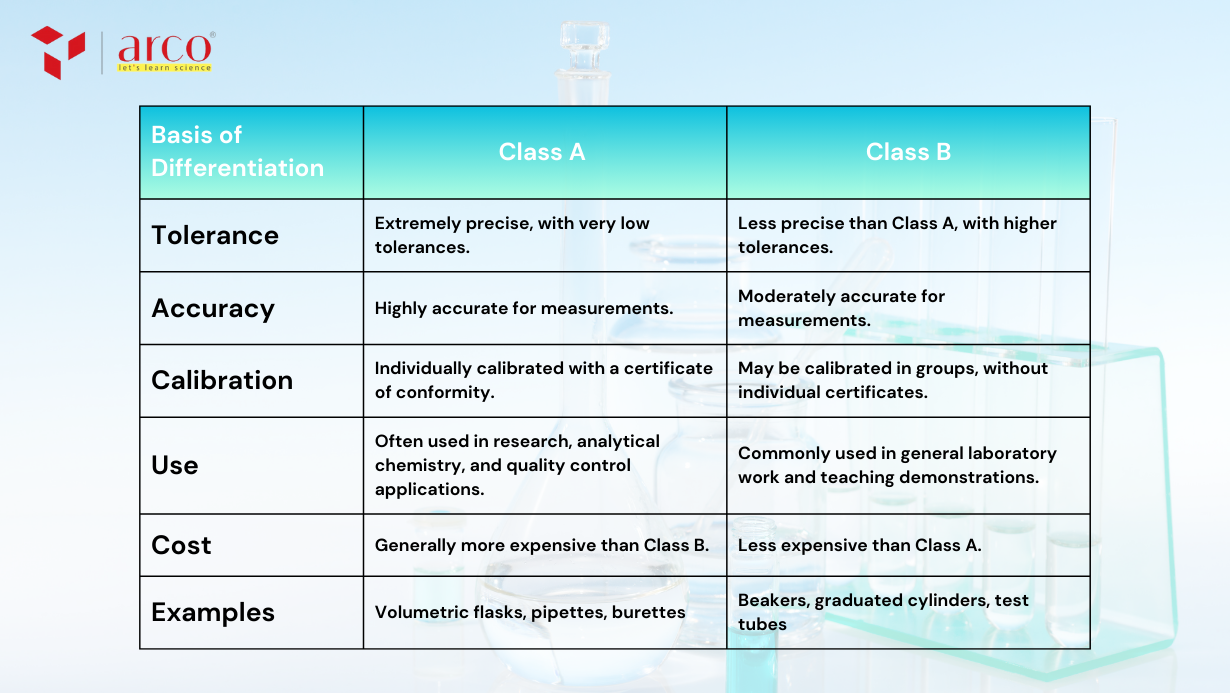Difference Class A and Class B Glassware
Summary: Ensuring accuracy and precision in laboratory settings depends on selecting the appropriate glassware. With an eye toward their functions, tolerances, and price, this article compares Class A vs Class B glassware. Understanding these differences will help you make wise decisions and improve the performance and dependability of your laboratory.
Important Realizations
- Class A glassware fits for necessary measurements as it is intended for outstanding accuracy.
- More reasonably priced and used for general purposes where accuracy is less critical is class B glassware.
- When choosing glassware for your laboratory requirements, consider tolerance, usage, and durability.
Any laboratory needs glassware as one of its basic instruments; its precision affects everything, including industrial uses and research results. Most of the time, labs employ Class A glassware to ensure high accuracy in sensitive experiments, while they use Class B glassware for more general applications where precision is less critical.
Knowing the distinctions between these two groups will enable you to choose which to apply in your procedures and experiments more wisely.
What is Laboratory Glassware?
Laboratory glassware refers to a variety of scientific tools that were mostly made of glass before plastic became more popular. Glass is highly versatile and can be shaped into different forms and sizes by molding, cutting, and most often, blowing.
Laboratory Glassware Classification
Internationally recognized standards divide lab glassware and glass into eight main groups:
Transportation and Interception Devices – This category includes items like glass joints, interfaces, valves, plugs, tubes, and rods, all of which are essential for transferring and controlling the flow of substances in the lab.
Containers – Examples of common lab containers include dishes, bottles, beakers, flasks, tanks, and test tubes. You can use these to store, hold, or mix various materials.
Basic Operating Instruments and Devices – These tools support fundamental lab processes such as absorption, drying, distillation, condensation, separation, evaporation, and extraction. They also assist with gas generation, chromatography, stirring, crushing, centrifugation, filtration, purification, and combustion. Glass instruments play a critical role in many of these operations.
Measuring Instruments – This group includes devices used to measure flow, specific gravity, pressure, temperature, and surface tension. Tools like droppers, pipettes, and syringes are also part of this category for their precision in measuring liquids.
Physical Measuring Instruments – These instruments help measure properties such as color, optical density, electrical parameters, phase changes, radioactivity, molecular weight, viscosity, and particle size.
Glassware for Chemical Analysis – These specialized instruments are designed to determine chemical elements and compounds, such as As, CO2, elemental analysis, atomic analysis, and metal elements. They also assist in detecting halogens and moisture levels.
Materials Testing Instruments – Instruments in this group are used to measure various materials such as atmosphere, gasses, explosives, metals, minerals, mineral oil, building materials, and water quality.
Food, Medicine, and Biological Analysis Instruments – This category includes tools for analyzing food, blood, and microbes, along with microscope accessories. Laboratories also use them for tests involving serum, vaccines, and urine.
Types of Glassware in Laboratory and Their Uses
There are various types of glassware in laboratory, each serving a specific purpose in various scientific tasks. Below, we’ve outlined some of the most commonly used pieces that are still prevalent today:
Beakers – Among the most basic and commonly used lab containers, beakers hold samples and reagents for various experiments.
Burettes – These are used for dispensing liquids in precise amounts, making them essential for accurate measurements.
Pipettes (Bulb and Graduated) – Designed to transfer small, measured volumes of liquid from one container to another.
Condensers – Available in many different types, condensers are used to either cool or heat liquids, depending on the experiment.
Desiccators – These are used to remove moisture from a substance, keeping samples dry.
Drying Pistols – Similar to desiccators, but they provide a more direct and efficient way to remove moisture.
Funnels – With their tapered neck, funnels allow liquids to be poured accurately into containers with narrow openings.
Glass Sampling Tubes – These are specifically designed for collecting small samples of liquid for further analysis.
Graduated Cylinders – Much like beakers, but with the added benefit of precise volume measurements.
Petri Dishes – A familiar tool from school labs, petri dishes are shallow, round containers used for culturing cells.
Slides – You place objects between two thin glass slides to view specimens under a microscope.
Vacuum Manifolds (Schlenk Lines) – A key tool in chemistry, especially useful for handling air-sensitive compounds.
Vials – Small bottles used for the storage of liquids or samples in the lab.
What is Class A Glassware?
Class A glassware is the most accurate of all the different kinds of glassware. The borosilicate material used to make this type of glassware gives it better qualities than other types. Moreover, Class A borosilicate glass is better at withstanding heat and chemicals, which is useful when working with chemicals that are popular in lab studies.
What is a Class B Glassware?
Class B glassware is designed for general use in the lab and is typically made from soda-lime glass. While it’s suitable for most compounds, it is not ideal for long-term chemical storage or exposure. The soda-lime composition of Class B glassware makes it less resistant to chemicals and heat compared to other types of glassware.
Class A vs Class B Glassware
The table below shows the difference between the Lab Glassware: Class A vs Class B
| Basis of Differentiation | Class A | Class B |
| Tolerance | Extremely precise, with very low tolerances. | Less precise than Class A, with higher tolerances. |
| Accuracy | Highly accurate for measurements. | Moderately accurate for measurements. |
| Calibration | Individually calibrated with a certificate of conformity. | May be calibrated in groups, without individual certificates. |
| Use | Often used in research, analytical chemistry, and quality control applications. | Commonly used in general laboratory work and teaching demonstrations. |
| Cost | Generally more expensive than Class B. | Less expensive than Class A. |
| Examples | Volumetric flasks, pipettes, burettes | Beakers, graduated cylinders, test tubes |
What is Best to Choose: Class A or Class B Glassware?
If your lab work requires extreme precision, there’s no substitute for Class A glassware. It is best for:
- Quantitative Research: Whether in a pharmaceutical lab, doing analytical chemistry, or working in a medical setting, Class A glassware is often a regulatory requirement.
- Quality Control Environments: Class A glassware is often mandatory in industries where precision affects product safety or performance.
- Regulated Testing Labs: If your lab is subject to compliance standards (e.g., ISO, FDA, or GLP).
- Clinical Laboratories: Medical labs that perform diagnostic tests often need the highest levels of precision.
Furthermore, only some labs call for the remarkable accuracy seen with Class A glassware. In some instances, Class B glassware is usually the most sensible choice:
- Teaching and Educational Labs: Class B glassware offers the durability and cost required to furnish a lab for big groups in an academic environment where students learn fundamental laboratory methods.
- General Lab Work: This type of glassware is a more affordable choice if daily work in your lab calls for routine operations in which accurate measurements are unnecessary.
- Non-regulated Industries: Class B glassware will usually satisfy your demands at a fraction of the cost if your lab is not subject to stringent regulatory control.
- Field Laboratories: Class B glassware provides a sturdy and reasonably priced alternative without compromising too much accuracy in mobile or field labs where glassware is prone to additional wear and tear.
Conclusion
Type A glassware is crucial for labs needing accuracy, certification, and regulatory compliance. Class B glassware, however, can offer dependable operation at a cheaper cost in more general lab settings where cost and durability are more factors of consideration.
Ultimately, the decision between Class A vs Class B glassware relies on your particular requirements and the type of work your lab is doing. Choosing the correct glassware will enable you to get consistent, dependable results in your tests, whether your priorities are the cost-effectiveness of Class B or the accuracy of Class A.
Contact us for further help; we offer premium Class A and Class B glassware that covers all your laboratory requirements.

